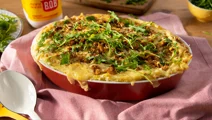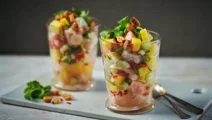
Fish and chips

Instructions
Tartar sauce
Chips
Fried fish
Tip
To get chips that are crispy on the outside, pat them thoroughly dry before frying them in oil. Make sure the oil is hot enough – 180°C – or the potatoes and cod will absorb too much oil, resulting in greasy and soggy chips and fish. Also, if it is too hot, the oil will burn the potatoes before frying them.
Tip
It is also important not to overfill the pan and allow enough room for the potatoes and fish when frying, otherwise, the temperature of the oil will lower significantly, which will affect the frying process.
Tip
Frying the chips twice ensures that they are fried through during the first fry, while the second achieves the ideal crunchy texture. Since the same oil is used for frying the chips and the cod, you should always fry the chips before the cod to ensure that the oil does not give the chips a fishy flavour.
Questions about fish and chips
Get acquainted with an iconic classic with our fish and chips recipe that you can enjoy for both lunch and dinner. To learn more about the ins and outs of this dish, read our answers to some of the most commonly asked questions below.
Ingredients
Tartar sauce
Sour cream, 9%, organic | 100 ml |
|---|---|
Chopped hard-boiled egg | 1 |
Gherkins | 3 |
Coarsely chopped capers | 2 tbsp |
Finely chopped fresh tarragon leaves | 2 tbsp |
Finely chopped red onion | 1 |
Coarse salt | ½ tsp |
Freshly ground pepper |
Chips
Scrubbed baked potatoes | 500 g |
|---|---|
Neutral-flavoured oil | 1 l |
Flake salt |
Fried fish
Wheat flour | 100 ml |
|---|---|
Coarse salt | ¼ tsp |
Milk | 50 ml |
Egg | 1 |
Melted butter | 10 g |
Cod fillet or pollock fillet without skin | 200 g |
Serve with
Lemon cut into wedges | 1 |
|---|---|
Vinegar, for example, malt vinegar |
Classic fish and chips with tartar sauce
Is there anything better than perfectly crisp chips with battered and fried fish? Fish and chips, or as it is sometimes spelt fish ‘n’ chips, is an iconic staple in British cuisine that has become a popular street food around the world. With our recipe, you can recreate the best fish and chips at home and pair it with some tasty sides and toppings. Homemade fish and chips is the perfect comfort dish whenever you are craving something crispy with rich flavours that is easy to make.
For more wonderful street food recipes, check out our recipe for hot dogs with homemade onion rings and serve these with traditional sauerkraut, or savour some shredded beef tacos or a few skewers of Greek souvlaki.
Dipped in tartar sauce and drizzled with malt vinegar
We serve fish and chips with vinegar and tartar sauce to round off all the flavours of the dish. Tartar sauce and malt vinegar have a tart, acidic aroma that cuts through the fish flavour and helps balance the richness from the batter and frying process.
The fish and chips sauce is prepared with crème fraiche, hard-boiled eggs, gherkins, capers, fresh tarragon leaves, red onion, and seasoning, giving it a nice creaminess with a bit of bite that is perfect to dip the fish and chips in.
Made from the malted grain of barley, malt vinegar is a culinary staple in British cuisine and goes hand in hand with the iconic dish. The acidity of malt vinegar enhances the delicious flavours and makes a rich addition when drizzled over the fried cod.
Fried treats brightened by sides and toppings
Who could resist a battered, fried fish that is crispy and flaky on the outside while remaining soft and tender on the inside? Battering the cod is an important step in creating Britain's most beloved dish. The batter is made with basic ingredients, including wheat flour, salt, milk, egg, and butter, and forms a protective coating for the cod that seals in its flavour and tenderness. The accompaniment of vinegar, tartar sauce, and a squeeze of lemon is a truly incredible combination and adds a bright touch to the fish and chips.
Choose the best fish for fish and chips
Choosing the right fish is essential for succeeding with fish and chips. Though there have been fierce debates over which fish is best for the culinary classic, we have a few suggestions that will help you pick the right one.
Cod is the most popular choice and, for many, the first fish that comes to mind when thinking about this British classic. It has a very mild flavour and extremely tender white meat that goes well with the malt vinegar and tartar sauce. If you like a contrast between the crispy coating and the delicate meat on the inside, cod is the top choice.
Most chefs use haddock for the dish as it has a slight sweetness that matches the rich buttery flavours of the batter. Though the texture is not as tender as cod, the meat has much more flavour, making it the preferred choice amongst professional chefs.
Also, pollock has gradually become more popular for fish and chips because it is juicy and tender and has a soft texture and stronger flavour than cod.
Make it your own
Although cod is delicious, try to make fish and chips with halibut. Halibut is thicker and firmer than cod, with a gentler flavour that pairs well with bolder seasonings, so you can give the halibut a spicy kick. Add cayenne pepper and chilli pepper (or chilli sauce) to the batter and coat the halibut with the spiced batter.
To make the batter crispier, add a bit of white beer and sparkling water to the batter. It will aerate the batter, making the final product airier and crispier. The beer also helps cut through the richness of the fried food, and the maltiness compliments the savoury flavours of the dish.










